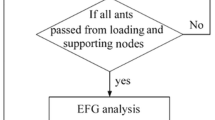Abstract
This paper examines the application of the ant colony optimization algorithm to the partitioning of unstructured adaptive meshes for parallel explicit time-stepping finite element analysis.
The concept of the ant colony optimization technique for finding approximate solutions to combinatorial optimization problems is described.
The application of ant colony optimization for partitioning finite element meshes based on triangular elements is described.
A recursive greedy algorithm optimization method is also presented as a local optimization technique to improve the quality of the solutions given by the ant colony optimization algorithm. The partitioning is based on the recursive bisection approach.
The mesh decomposition is carried out using normal and predictive modes for which the predictive mode uses a trained multilayered feed-forward neural network which estimates the number of triangular elements that will be generated after finite elements mesh generation is carried out.
The performance of the proposed hybrid approach for the recursive bisection of finite element meshes is examined by decomposing two mesh examples.
Similar content being viewed by others
References
Bahreininejad, A.; Topping, B.H.V. 1996: Finite element mesh partitioning using neural networks. Adv Eng Softw27, 103–115
Bonabeau, E.; Dorigo, M.; Theraulaz, G. 2000: Inspiration for optimization from social insect behavior. Nature406, 39–42
Bui, T.N.; Strite, L.C. 2002: An ant system algorithm for graph bisection. GECCO 2002: Proceedings of the Genetic and Evolutionary Computation Conference, USA Morgan Kaufmann, 43–51
Colorni, A.; Dorigo, M.; Maniezzo, V. 1991: Distributed optimization by ant colonies. Proceedings of the first European Conference on Artificial Life, USA, 134–142
Dorigo, M.; Gambardella, L. 1997: Ant colony system: a cooperative learning approach to the traveling salesman problem. IEEE Trans Evol Comput1(1), 53–66
Kuntz, P.; Layzell, P.; Snyers, D. 1997: A colony of ant-like agents for partitioning in VLSI technology. Proceedings of the Fourth European Conference on Artificial Life, 417–424
Kuntz, P.; Snyers, D. 1994: Emergent colonization and graph partitioning. Proceedings of the Third International Conference on Simulation of Adaptive Behavior: From Animals to Animats3, 494–500
Maniezzo, V.; Carbonaro, A. 2001: Ant colony optimization: an overview. In: Essays and Surveys in Metaheuristics, Kluwer Academic, 21–44
Pao, Y.H. 1989: Adaptive pattern recognition and neural networks. Addison-Wesley, USA
Topping, B.H.V.; Bahreininejad, A. 1997: Neural computing for structural mechanics. Saxe-Coburg, UK
Topping, B.H.V.; Khan, A.I. 1996: Parallel finite element computations. Saxe-Coburg, UK
Author information
Authors and Affiliations
Corresponding author
Rights and permissions
About this article
Cite this article
Bahreininejad, A. A hybrid ant colony optimization approach for finite element mesh decomposition. Struct Multidisc Optim 28, 307–316 (2004). https://doi.org/10.1007/s00158-004-0432-x
Received:
Revised:
Published:
Issue Date:
DOI: https://doi.org/10.1007/s00158-004-0432-x




